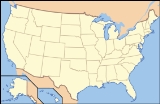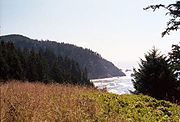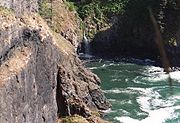
Cascade Head
Encyclopedia
Cascade Head is a headland
and 270 acres (109.3 ha) UNESCO biosphere reserve
and United States Forest Service
Experimental Forest. It is situated 85 miles (136.8 km) southwest of Portland, Oregon
on the Oregon Coast
between Lincoln City
and Neskowin
. Cascade Head Preserve is a Nature Conservancy Selected Site.
. Because of its ecological significance, Cascade Head Preserve and surrounding national forest and other lands won recognition in 1980 as a National Scenic Research Area and a United Nations Biosphere Reserve.
Conservancy researchers are testing methods of maintaining and restoring grassland habitat for the Oregon silverspot butterfly, including prescribed fire. Conservancy ecologists also monitor the populations of rare plants throughout the year. In spring and summer, teams of volunteers remove invasive species (such as Himalayan blackberry), help maintain trails, assist with research projects, and teach visitors about the Preserve.
 The 11890 acres (4,811.7 ha) Cascade Head Experimental Forest was established in 1934 for scientific study of typical coastal Sitka spruce-western hemlock forests found along the Oregon Coast. The forest stands at Cascade Head have been used for long-term studies, experimentation, and ecosystem research since then. In 1974 an act of Congress established the 9670 acres (3,913.3 ha) Cascade Head Scenic Research Area that includes the western half of the experimental forest, several prairie headlands, the Salmon River
The 11890 acres (4,811.7 ha) Cascade Head Experimental Forest was established in 1934 for scientific study of typical coastal Sitka spruce-western hemlock forests found along the Oregon Coast. The forest stands at Cascade Head have been used for long-term studies, experimentation, and ecosystem research since then. In 1974 an act of Congress established the 9670 acres (3,913.3 ha) Cascade Head Scenic Research Area that includes the western half of the experimental forest, several prairie headlands, the Salmon River
estuary to the south, and contiguous private lands.
Before the establishment of the experimental forest in 1934 and for sometime after, an intense forest inventory was done to determine distribution, age classes, and volumes of major tree species. Early research at Cascade Head includes studies that determined life history and characteristics of native tree species; growth and yield of Sitka spruce
-western hemlock, Douglas-fir
, and red alder
stands; and basic relations between vegetation and climate. A climate station established in 1936 is still operating and is an official United States Weather Bureau site. Between the 1940s and the 1960s, experimental, commercial sized harvests were done to evaluate the silvicultural
and economic results of various tree-cutting methods. Current research is being done on forest ecosystem productivity, wind disturbance, nutrient cycling, and global carbon cycling.
Research on the Salmon River estuary has been ongoing since the first dike breaching in 1979. Reestablishment of the salt marsh ecosystems continues to be studied and more recently use of these restored ecosystems by anadromous fish is being studied.
 Cascade Head is home to many native plant species, including Red Fescue, wild rye
Cascade Head is home to many native plant species, including Red Fescue, wild rye
, Pacific Reedgrass
, coastal paintbrush, goldenrod
, blue violet and stream bank Lupin
e. The Hairy checkermallow
is a rare flower found here.
Ninety-nine percent of the world's population of the Cascade Head catchfly
is found here. The Oregon silverspot butterfly, federally listed as a threatened species, is known to only five other locations in the world. The butterfly depends on a single plant species, the early blue violet (which grows coastal grassland openings), to serve as food for its larvae. Elk
, deer
, coyote
, snowshoe hare
and the Pacific giant salamander
are also found in the preserve, as well as bald eagle
, great horned owl
, northern harrier, red-tail hawk and the occasional peregrine falcon
.
Headlands and bays
Headlands and bays are two related features of the coastal environment.- Geology and geography :Headlands and bays are often found on the same coastline. A bay is surrounded by land on three sides, whereas a headland is surrounded by water on three sides. Headlands are characterized by high,...
and 270 acres (109.3 ha) UNESCO biosphere reserve
Biosphere reserve
The Man and the Biosphere Programme of UNESCO was established in 1971 to promote interdisciplinary approaches to management, research and education in ecosystem conservation and sustainable use of natural resources.-Development:...
and United States Forest Service
United States Forest Service
The United States Forest Service is an agency of the United States Department of Agriculture that administers the nation's 155 national forests and 20 national grasslands, which encompass...
Experimental Forest. It is situated 85 miles (136.8 km) southwest of Portland, Oregon
Portland, Oregon
Portland is a city located in the Pacific Northwest, near the confluence of the Willamette and Columbia rivers in the U.S. state of Oregon. As of the 2010 Census, it had a population of 583,776, making it the 29th most populous city in the United States...
on the Oregon Coast
Oregon Coast
The Oregon Coast is a region of the U.S. state of Oregon. It runs generally north-south along the Pacific Ocean, forming the western border of the state; the region is bounded to the east by the Oregon Coast Range. The Oregon Coast stretches approximately from the Columbia River in the north to...
between Lincoln City
Lincoln City, Oregon
Lincoln City is a city in Lincoln County, Oregon, United States. It is named after the county. The population was 7,930 at the 2010 census.- History :...
and Neskowin
Neskowin, Oregon
Neskowin is an unincorporated community in Tillamook County, Oregon, United States, near where Slab Creek empties into the Pacific Ocean. For statistical purposes, the United States Census Bureau has defined Neskowin as a census-designated place . The census definition of the area may not...
. Cascade Head Preserve is a Nature Conservancy Selected Site.
The Nature Conservancy
In the early 1960s, volunteers organized an effort to protect Cascade Head from development. By 1966 they had raised funds and purchased the property, and then turned it over to The Nature ConservancyThe Nature Conservancy
The Nature Conservancy is a US charitable environmental organization that works to preserve the plants, animals, and natural communities that represent the diversity of life on Earth by protecting the lands and waters they need to survive....
. Because of its ecological significance, Cascade Head Preserve and surrounding national forest and other lands won recognition in 1980 as a National Scenic Research Area and a United Nations Biosphere Reserve.
Conservancy researchers are testing methods of maintaining and restoring grassland habitat for the Oregon silverspot butterfly, including prescribed fire. Conservancy ecologists also monitor the populations of rare plants throughout the year. In spring and summer, teams of volunteers remove invasive species (such as Himalayan blackberry), help maintain trails, assist with research projects, and teach visitors about the Preserve.
Experimental Forest

Salmon River (Lincoln County, Oregon)
The Salmon River flows from the Central Oregon Coast Range to the Pacific Ocean coast of northwest Oregon in the United States. About long, it begins and ends in Lincoln County but also flows briefly through western Polk and southern Tillamook counties....
estuary to the south, and contiguous private lands.
Before the establishment of the experimental forest in 1934 and for sometime after, an intense forest inventory was done to determine distribution, age classes, and volumes of major tree species. Early research at Cascade Head includes studies that determined life history and characteristics of native tree species; growth and yield of Sitka spruce
Sitka Spruce
Picea sitchensis, the Sitka Spruce, is a large coniferous evergreen tree growing to 50–70 m tall, exceptionally to 95 m tall, and with a trunk diameter of up to 5 m, exceptionally to 6–7 m diameter...
-western hemlock, Douglas-fir
Douglas-fir
Douglas-fir is one of the English common names for evergreen coniferous trees of the genus Pseudotsuga in the family Pinaceae. Other common names include Douglas tree, and Oregon pine. There are five species, two in western North America, one in Mexico, and two in eastern Asia...
, and red alder
Red Alder
Alnus rubra, the Red alder, is a deciduous broadleaf tree native to western North America.-Description:It is the largest species of alder in North America and one of the largest in the world, reaching heights of 20–35 m. The official tallest red alder stands 32 meters tall in Clatsop County, Oregon...
stands; and basic relations between vegetation and climate. A climate station established in 1936 is still operating and is an official United States Weather Bureau site. Between the 1940s and the 1960s, experimental, commercial sized harvests were done to evaluate the silvicultural
Silviculture
Silviculture is the practice of controlling the establishment, growth, composition, health, and quality of forests to meet diverse needs and values. The name comes from the Latin silvi- + culture...
and economic results of various tree-cutting methods. Current research is being done on forest ecosystem productivity, wind disturbance, nutrient cycling, and global carbon cycling.
Research on the Salmon River estuary has been ongoing since the first dike breaching in 1979. Reestablishment of the salt marsh ecosystems continues to be studied and more recently use of these restored ecosystems by anadromous fish is being studied.
Flora and fauna

Wild rye
Wild rye is a term used for several grasses. They are natively found in parts of North America and are valuable in the control of exotic invasive plants and as a rotation crop."Wild ryes" belong to either of two genera:...
, Pacific Reedgrass
Calamagrostis
Calamagrostis, or Small-reed or Reedgrass, is a genus in the Grass family Poaceae with about 260 species that occur mainly in temperate regions of the Northern Hemisphere and the southern hemisphere. Towards equatorial latitudes, species of Calamagrostis generally occur at higher elevations in...
, coastal paintbrush, goldenrod
Goldenrod
Solidago, commonly called goldenrods, is a genus of about 100 species of flowering plants in the family Asteraceae. Most are herbaceous perennial species found in the meadows and pastures, along roads, ditches and waste areas in North America. There are also a few species native to Mexico, South...
, blue violet and stream bank Lupin
Lupin
Lupinus, commonly known as Lupins or lupines , is a genus in the legume family . The genus comprises about 280 species , with major centers of diversity in South and western North America , and the Andes and secondary centers in the Mediterranean region and Africa Lupinus, commonly known as Lupins...
e. The Hairy checkermallow
Sidalcea
Sidalcea is a genus of the botanical family Malvaceae. It contains several species of flower known generally as checkerblooms or checkermallows.Selected species:*Sidalcea calycosa - annual checkerbloom...
is a rare flower found here.
Ninety-nine percent of the world's population of the Cascade Head catchfly
Catchfly
Catchfly may refer to:* Lychnis, genus of Caryophyllaceae* Silene, genus of Caryophyllaceae...
is found here. The Oregon silverspot butterfly, federally listed as a threatened species, is known to only five other locations in the world. The butterfly depends on a single plant species, the early blue violet (which grows coastal grassland openings), to serve as food for its larvae. Elk
Elk
The Elk is the large deer, also called Cervus canadensis or wapiti, of North America and eastern Asia.Elk may also refer to:Other antlered mammals:...
, deer
Deer
Deer are the ruminant mammals forming the family Cervidae. Species in the Cervidae family include white-tailed deer, elk, moose, red deer, reindeer, fallow deer, roe deer and chital. Male deer of all species and female reindeer grow and shed new antlers each year...
, coyote
Coyote
The coyote , also known as the American jackal or the prairie wolf, is a species of canine found throughout North and Central America, ranging from Panama in the south, north through Mexico, the United States and Canada...
, snowshoe hare
Snowshoe Hare
The Snowshoe Hare , also called the Varying Hare, or Snowshoe Rabbit, is a species of hare found in North America. It has the name "snowshoe" because of the large size of its hind feet and the marks its tail leaves. The animal's feet prevent it from sinking into the snow when it hops and walks...
and the Pacific giant salamander
Pacific giant salamander
Pacific giant salamanders are a family of large salamanders.The family includes only a single genus, Dicamptodon. The genus was formerly thought to contain two species, Cope's Giant Salamander on the Olympic Peninsula, Washington, and the Pacific giant salamander Pacific giant salamanders...
are also found in the preserve, as well as bald eagle
Bald Eagle
The Bald Eagle is a bird of prey found in North America. It is the national bird and symbol of the United States of America. This sea eagle has two known sub-species and forms a species pair with the White-tailed Eagle...
, great horned owl
Great Horned Owl
The Great Horned Owl, , also known as the Tiger Owl, is a large owl native to the Americas. It is an adaptable bird with a vast range and is the most widely distributed true owl in the Americas.-Description:...
, northern harrier, red-tail hawk and the occasional peregrine falcon
Peregrine Falcon
The Peregrine Falcon , also known as the Peregrine, and historically as the Duck Hawk in North America, is a widespread bird of prey in the family Falconidae. A large, crow-sized falcon, it has a blue-gray back, barred white underparts, and a black head and "moustache"...
.

